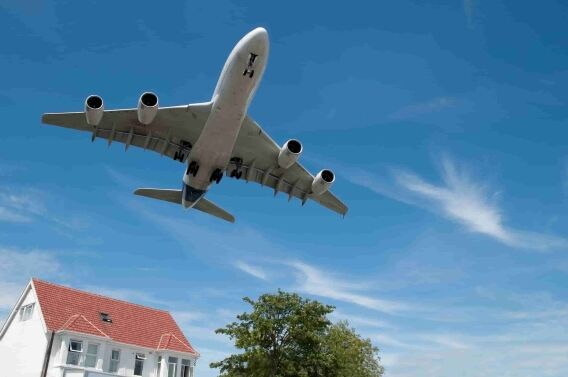
Airline Flight Paths: Do They Affect Property Prices?
The success of budget airlines and over 40 commercial airports from Land’s End to Stornoway means air travel in the UK is more convenient than ever.
We love this convenience – as long as it’s not on our doorstep. Noise and pollution can how desirable a house is.
So, how do airline flight paths affect the price of a property?
Plane flight paths – a noisy inconvenience
According to NATS (The National Air Traffic Control Services), May 2019 saw more than 235,000 flights over UK airspace – the busiest month on record to this point. With the number of flights climbing steadily, there is an associated increase in noise and air pollution.
Noisy airline routes
Noise is probably top of the list of concerns when buying a property near an airport. But with improvements in technology, noise pollution could soon become a non-issue for people living nearby.
The highest level of noise pollution is inevitably next to the busiest airports. Sound at Heathrow is classified as ‘significantly annoying’, impacting more people than any other airport in Europe, according to the Civil Aviation Authority (CAA).
An occasional plane flying overhead may be very noisy for a short period. But if aircraft are continually taking off and landing nearby, that’s a steady sound level of more than 57 decibels, and you have a problem.
This means that for most people, including potential buyers, aircraft noise if it is consistent and loud, may negatively affect house market prices.
Can anything be done?
Most airports in the world recognise the distress that aircraft noise causes and try to alleviate problems for local communities where possible.
There are rules (Noise Abatement Procedures) governing how pilots behave on take-off, while Air Traffic Control often have specific routes to direct departing aircraft away from communities that suffer the worst noise pollution.
Most UK airports also offer insulation schemes to the worse affected homeowners to pay for noise-reducing loft insulation and replacement windows.
Air pollution concerns
Unfortunately, aircraft engines emit pollutants, with take-off and landing the most polluting. It is when aircraft produce maximum emissions and when they make the most noise. This affects air quality, particularly for those working and living near an airport.
Living below a flight path, the impact on health can be wide-ranging but particularly with those who suffer from respiratory illnesses. Chief among the pollutants are nitrogen dioxide, and nitric oxide says the CAA.
Research has also indicated that substantial air traffic creates particles that can enter the lungs and the bloodstream. Bad news if you have a condition such as asthma or other breathing issues.
If your health is a concern, the closer to an airport you are looking to buy, the more critical these factors may be, but note there may be other contributing factors apart from the air traffic.
House prices near airports
Suppose you find a property near an airport that ticks a lot of your boxes. Does all the good outweigh that one lousy point? And is it really a negative at all?
Location can increase property value, and low-flying aircraft may be damaging to prices in the surrounding area. It is hard to measure the impact of just an airport on house prices, though, as there other factors that can contribute.
Often if an airport is going to be built or expanded – such as the third runway at Heathrow – many residents sell in anticipation of the disruption and potential increase in noise and pollution.
Because of this, houses under flight routes and close to airports can cost significantly less than surrounding areas without the same problem.
If you are looking at a home near an airport, check their website. It will have a flight map and even map out the noise pollution for you. There are also some great apps such as Airspace Explorer that give real-time data to help in your search.
Upside for buyers
While you should think about pollution and possible health concerns, there can be advantages of living near an airport as well.
Lower house prices, while bad news for sellers, can be helpful if you are a buyer, especially if other areas are out of your budget. Remember though, you will probably want to sell your home at some point – future buyers may have their own concerns about how close it is to an airport. It could make climbing the property ladder more difficult.
Lower prices could mean an improved situation for some consumers and proximity to airports can be desirable for renters over buyers, especially from people working at the airport or linked businesses.
Living close (but not too close) to an airport can be convenient for frequent travellers also, particularly those going long distances. Usually, transport links to city centres and business districts are excellent, giving residents an advantage when it comes to travelling and commuting.
Do your homework if you’re thinking of buying near an airport
There are pros and cons of living near an airport.
On the plus side is the convenience of not just air travel, but the associated transport links and often, lower prices. But, there is the genuine concern raised by the noise, pollution and health risks.
It’s a good idea to do your research before deciding to buy near an airport. Consider your own health and try to speak with people who already live in the area to get their opinion on living there.
Buying a new home?
If you are buying a home, you’ll want to educate yourself about whether aircraft noise affects the home.
In addition, Phil Spencer’s property report will provide you with more information on local schools and nearby planning applications. It can really help to inform your decision to buy a property in a certain area and, in some cases, might even help you during the negotiation process.
Last Updated: September 22nd, 2024







